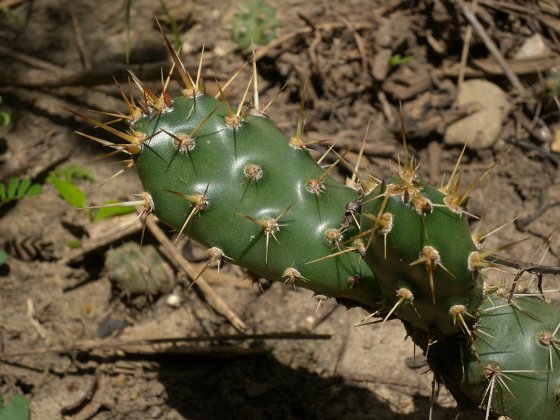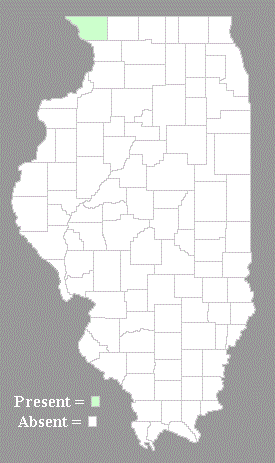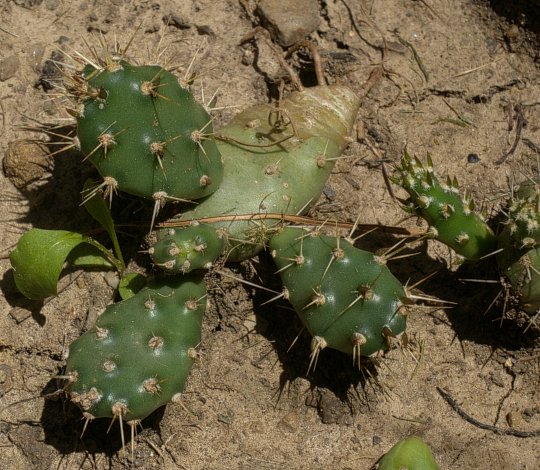
While most plants fail to bloom during a given year, usually a small minority of plants in a colony will produce 1-2 flowers each. Each flower is about 1½-2" (4-5 cm.) across when it is fully open, consisting of several rounded yellow tepals, numerous stamens, and a pistil with a single slender style. Sometimes the inner tepals are reddish or greenish at their bases. The filaments of the stamens are yellow or reddish brown, while their anthers are yellow. The style is whitish yellow with a cluster of 4-10 green stigmata at its tip. For a colony of plants, the blooming period occurs during mid-summer for about 1-2 weeks; each diurnal flower lasts only a single day. Sometimes there is a slight floral fragrance. Most flowers fail to set fruit. Among those that do, their fruits are ½-¾" (12-20 mm.) long and ovoid in shape. Immature fruits are green to reddish green, while mature fruits are tan to brown and bur-like in appearance. Like the pads, the fruits have areoles with glochids and barbed spines; the spines are more common toward the apex of each fruit. The interior of mature fruits is dry and seedy. These fruits are easily detached from their pads. Individual seeds are 4-6 mm. across, bone-colored to grayish brown, and hairless; they are rather chunky and irregular in shape. The root system is shallow and fibrous. This plant can reproduce vegetatively whenever detached pads have contact with the ground surface, as they will
 form new roots. This is the
primary method of
reproduction. It is not uncommon for little-disturbed plants to form
sprawling colonies at favorable sites.
form new roots. This is the
primary method of
reproduction. It is not uncommon for little-disturbed plants to form
sprawling colonies at favorable sites.Cultivation: The preference is full sun, dry conditions, and open barren ground that is rocky, gravelly, or sandy. However, this cactus will adapt to ordinary garden soil if other plants are kept away from it. Under these conditions, it is not difficult to cultivate, however flowers and fruits are uncommonly produced in most geographical areas where this cactus occurs. This dwarf cactus is a good candidate for a sunny rock garden. It is the most winter-hardy cactus in North America.
Range & Habitat: The native Brittle Prickly Pear is found in only the NW corner of Illinois, where it is rare and state-listed as 'endangered.' Illinois lies along the eastern range-limit of this cactus; it is more common in areas further to the west, especially in the northern plains region of the United States. In Illinois, Brittle Prickly Pear occurs on a dry sand prairie of an abandoned army base that is in the process of being restored. Outside of the state, this cactus can be found in open grassy prairies, sandy hills, and rocky outcrops containing granite, limestone, or quartzite. In Illinois, this cactus is found in a higher quality natural area, while toward the center of its range, it sometimes occurs in disturbed areas (e.g., cattle pastures).
Faunal Associations: The nectar and pollen of the flowers attract primarily bees, including Halictid bees. Insects that feed destructively on Brittle Prickly Pear and other Opuntia spp. include the Coreid bug, Chelinidea vittiger, which sucks juices from the cactus pads and fruits; the stink bugs, Chlorochroa uhleri and Chlorochroa persimilis, which also suck juices from the cactus pads and fruits; larvae of the Syrphid fly, Copestylum vittatum, which bore into the cactus pads; and larvae of the Pyralid moths, Melitara dentata and Melitara prodenialis, which also bore into the cactus pads. The sharp spines and bristly glochids provide the cactus pads and fruits with some protection from browsing by vertebrate herbivores. Nonetheless, in some areas the Brittle Prickly Pear is eaten by the Plains Pocket Gopher, and its seeds are an important source of food for the Harris Ground Squirrel and many species of birds (Ribbens, 2007). Among cacti, the Brittle Prickly Pear is unusual in having individual pads and fruits that are designed to attach themselves to the fur of mammals, such as the American Bison; they also become attached to the clothing and skin of humans. By such means, new clonal plants and seeds can be transported across long distances.

Photographic Location: The wildflower garden of the webmaster in Urbana, Illinois.
Comments: In Illinois, Brittle Prickly Pear can be distinguished from other Opuntia spp. (Prickly Pears) by its small size and dry bur-like fruits. Like many other cacti, it produces large showy flowers that are short-lived. The detachable pads make this cactus difficult to handle while transplanting as they readily cling to fingers, hands, or gloves, thanks to its barbed spines. In particular, the inconspicuous glochids (fine sharp bristles of the areoles) can embed themselves underneath the surface of the skin and are difficult to remove. So its wise to exercise considerable care while handling this plant. Not only can the pads become detached by the movements of animals or people, even heavy rainfall, blowing snow, or a strong gust wind sometimes dislodge them. Each one of these detached pads has the potential to become another clonal plant, forming low mats of sprawling plants over time.